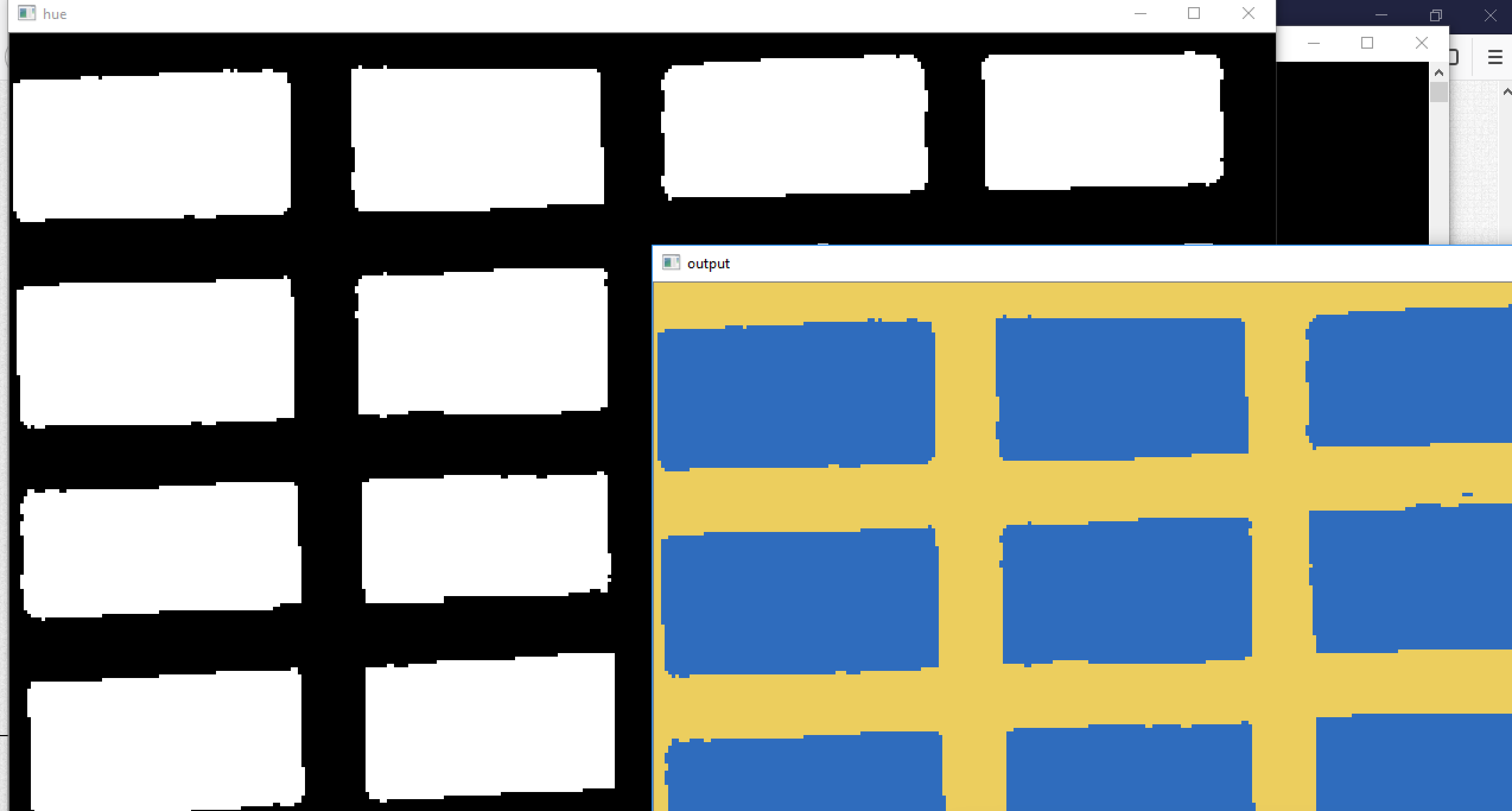This forum is disabled, please visit https://forum.opencv.org
 | 1 | initial version |
I found your mask using a small amount of code. It should be fairly easy to convert it from C++ to Python:
// Load image
Mat bgr_frame = imread("glare.png");
if (bgr_frame.empty())
{
cout << "Error loading image file" << endl;
return -1;
}
// Convert from BGR to HSV
Mat hsv_frame;
cvtColor(bgr_frame, hsv_frame, CV_BGR2HSV);
// Split HSV image into H, S, V channels
Mat channels[3];
split(hsv_frame, channels);
// Perform threshold on the H channel
threshold(channels[0], channels[0], 63, 255, CV_THRESH_BINARY);
imshow("hue", channels[0]);
waitKey();
 | 2 | No.2 Revision |
I found your mask using a small amount of code. It should be fairly easy to convert it from C++ to Python:
// Load image
Mat bgr_frame = imread("glare.png");
if (bgr_frame.empty())
{
cout << "Error loading image file" << endl;
return -1;
}
// Convert from BGR to HSV
Mat hsv_frame;
cvtColor(bgr_frame, hsv_frame, CV_BGR2HSV);
// Split HSV image into H, S, V channels
Mat channels[3];
split(hsv_frame, channels);
// Perform threshold on the H channel
threshold(channels[0], channels[0], 63, 255, CV_THRESH_BINARY);
Mat output(channels[0].rows, channels[0].cols, CV_8UC3);
for (int j = 0; j < channels[0].rows; j++)
{
for (int i = 0; i < channels[0].cols; i++)
{
unsigned char val = channels[0].at<unsigned char>(j, i);
if (255 == val)
{
output.at<Vec3b>(j, i)[0] = 127;
output.at<Vec3b>(j, i)[1] = 0;
output.at<Vec3b>(j, i)[2] = 0;
}
else
{
output.at<Vec3b>(j, i)[0] = 0;
output.at<Vec3b>(j, i)[1] = 0;
output.at<Vec3b>(j, i)[2] = 127;
}
}
}
imshow("hue", channels[0]);
imshow("output", output);
waitKey();
 | 3 | No.3 Revision |
I found your mask using a small amount of code. It should be fairly easy to convert it from C++ to Python:
Mat bgr_frame = imread("glare.png");
if (bgr_frame.empty())
{
cout << "Error loading image file" << endl;
return -1;
}
Mat hsv_frame;
cvtColor(bgr_frame, hsv_frame, CV_BGR2HSV);
Mat channels[3];
split(hsv_frame, channels);
threshold(channels[0], channels[0], 63, 255, CV_THRESH_BINARY);
Mat output(channels[0].rows, channels[0].cols, CV_8UC3);
for (int j = 0; j < channels[0].rows; j++)
{
for (int i = 0; i < channels[0].cols; i++)
{
unsigned char val = channels[0].at<unsigned char>(j, i);
if (255 == val)
{
output.at<Vec3b>(j, i)[0] = 127;
189;
output.at<Vec3b>(j, i)[1] = 0;
108;
output.at<Vec3b>(j, i)[2] = 0;
47;
}
else
{
output.at<Vec3b>(j, i)[0] = 0;
94;
output.at<Vec3b>(j, i)[1] = 0;
206;
output.at<Vec3b>(j, i)[2] = 127;
}
}
}
236;
}
}
}
imshow("hue", channels[0]);
imshow("output", output);
waitKey();
 | 4 | No.4 Revision |
I found your mask using a small amount of code. It should be fairly easy to convert it from C++ to Python:
Mat bgr_frame = imread("glare.png");
if (bgr_frame.empty())
{
cout << "Error loading image file" << endl;
return -1;
}
Mat hsv_frame;
cvtColor(bgr_frame, hsv_frame, CV_BGR2HSV);
Mat channels[3];
split(hsv_frame, channels);
threshold(channels[0], channels[0], 63, 255, CV_THRESH_BINARY);
Mat output(channels[0].rows, channels[0].cols, CV_8UC3);
for (int j = 0; j < channels[0].rows; j++)
{
for (int i = 0; i < channels[0].cols; i++)
{
unsigned char val = channels[0].at<unsigned char>(j, i);
if (255 == val)
{
output.at<Vec3b>(j, i)[0] = 189;
output.at<Vec3b>(j, i)[1] = 108;
output.at<Vec3b>(j, i)[2] = 47;
}
else
{
output.at<Vec3b>(j, i)[0] = 94;
output.at<Vec3b>(j, i)[1] = 206;
output.at<Vec3b>(j, i)[2] = 236;
}
}
}
imshow("hue", channels[0]);
imshow("output", output);
waitKey();
 | 5 | No.5 Revision |
I found your mask using a small amount of code. statements. It should be fairly easy to convert it from C++ to Python:
Mat bgr_frame = imread("glare.png");
if (bgr_frame.empty())
{
cout << "Error loading image file" << endl;
return -1;
}
Mat hsv_frame;
cvtColor(bgr_frame, hsv_frame, CV_BGR2HSV);
Mat channels[3];
split(hsv_frame, channels);
threshold(channels[0], channels[0], 63, 255, CV_THRESH_BINARY);
Mat output(channels[0].rows, channels[0].cols, CV_8UC3);
for (int j = 0; j < channels[0].rows; j++)
{
for (int i = 0; i < channels[0].cols; i++)
{
unsigned char val = channels[0].at<unsigned char>(j, i);
if (255 == val)
{
output.at<Vec3b>(j, i)[0] = 189;
output.at<Vec3b>(j, i)[1] = 108;
output.at<Vec3b>(j, i)[2] = 47;
}
else
{
output.at<Vec3b>(j, i)[0] = 94;
output.at<Vec3b>(j, i)[1] = 206;
output.at<Vec3b>(j, i)[2] = 236;
}
}
}
imshow("hue", channels[0]);
imshow("output", output);
waitKey();
 | 6 | No.6 Revision |
I found your mask using a small amount of statements. It should be fairly easy to convert it from C++ to Python:
Mat bgr_frame = imread("glare.png");
if (bgr_frame.empty())
{
cout << "Error loading image file" << endl;
return -1;
}
Mat hsv_frame;
cvtColor(bgr_frame, hsv_frame, CV_BGR2HSV);
Mat channels[3];
split(hsv_frame, channels);
threshold(channels[0], channels[0], 63, 255, CV_THRESH_BINARY);
Mat output(channels[0].rows, channels[0].cols, CV_8UC3);
for (int j = 0; j < channels[0].rows; j++)
{
for (int i = 0; i < channels[0].cols; i++)
{
unsigned char val = channels[0].at<unsigned char>(j, i);
if (255 == val)
{
output.at<Vec3b>(j, i)[0] = 189;
output.at<Vec3b>(j, i)[1] = 108;
output.at<Vec3b>(j, i)[2] = 47;
}
else
{
output.at<Vec3b>(j, i)[0] = 94;
output.at<Vec3b>(j, i)[1] = 206;
output.at<Vec3b>(j, i)[2] = 236;
}
}
}
imshow("hue", channels[0]);
imshow("output", output);
waitKey();
The mask and output look like this:

 | 7 | No.7 Revision |
I found your mask using a very small amount number of statements. It should be fairly easy to convert it from C++ to Python:
// Load main image
Mat bgr_frame = imread("glare.png");
if (bgr_frame.empty())
{
cout << "Error loading image file" << endl;
return -1;
}
// Convert from BGR to HSV
Mat hsv_frame;
cvtColor(bgr_frame, hsv_frame, CV_BGR2HSV);
// Split HSV into H, S, V channels
Mat channels[3];
split(hsv_frame, channels);
// Get mask
threshold(channels[0], channels[0], 63, 255, CV_THRESH_BINARY);
// Use mask to generate a BGR image
Mat output(channels[0].rows, channels[0].cols, CV_8UC3);
for (int j = 0; j < channels[0].rows; j++)
{
for (int i = 0; i < channels[0].cols; i++)
{
unsigned char val = channels[0].at<unsigned char>(j, i);
if (255 == val)
{
output.at<Vec3b>(j, i)[0] = 189;
output.at<Vec3b>(j, i)[1] = 108;
output.at<Vec3b>(j, i)[2] = 47;
}
else
{
output.at<Vec3b>(j, i)[0] = 94;
output.at<Vec3b>(j, i)[1] = 206;
output.at<Vec3b>(j, i)[2] = 236;
}
}
}
imshow("hue", channels[0]);
imshow("output", output);
waitKey();
The mask and output look like this:
